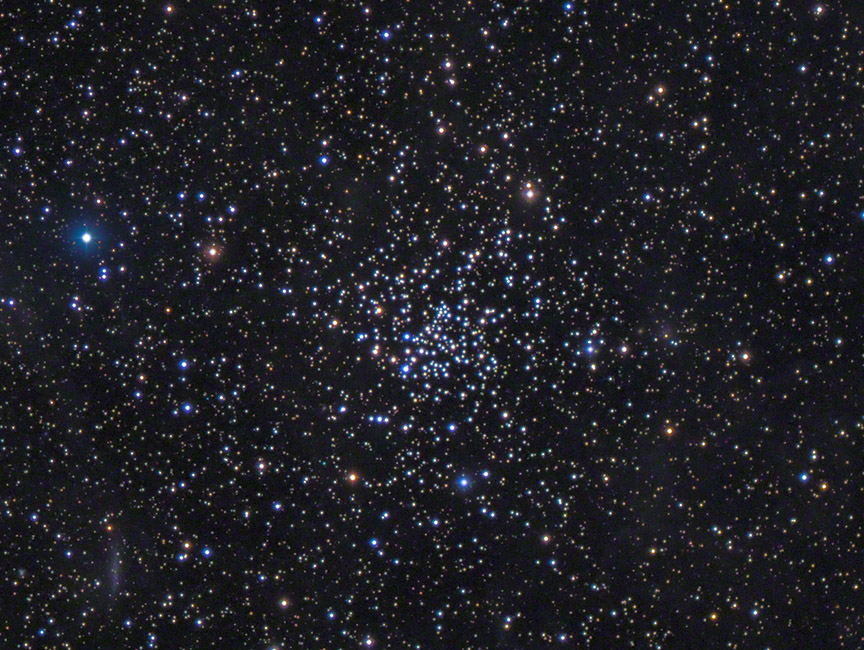
This is a dim open cluster, and pretty compact. A few of the brighter stars are easily visible, but most of the members are fainter and difficult to resolve. It looks like a faint fuzzy patch with sprinkles of faint stars.
| Observer: | Tom Campbell |
| Location: | College Station, Texas (Long: 101°56'W Lat: 33°47'N) |
| Telescope: | Zhumell 12" f/5 Dobsonian |
Today was another fine, clear day, with a high temperature of about 80. It was hard to believe I would be getting two observing nights in a row centered around a New Moon.
I set up the telescope in my back yard, hoping to see a few "new to me" planetary nebulae and possibly a galaxy or two.
| 15 | Double Star | Aquila | 8:45pm CDT | |
While waiting for the skies to darken a bit more, I saw this binary star on my list. It is a nice double, easily split at 83x. Both stars are bright, with the brighter component being a pale yellow and a slightly fainter companion appearing orange. A pretty pair that I'm surprised I haven't looked at yet. |
||||
While in the area of Aquila, I thought I'd try for a few objects there. First on my list was NGC 6822 (Barnard's Galaxy). Fail! I starhopped carefully and knew I had the telescope pointed in exactly the right spot, but I really couldn't discern anything there. I was a bit disappointed, but not really surprised.
I've had some good luck with planetary nebulae lately, so I thought I'd try for one of those next. NGC 6741 (Phantom Streak) looked promising, so I tried for it. Again, nothing. Well, this was really starting to get frustrating.
I stepped away from the telescope for a few minutes and just took in the night sky with my naked eyes. It was a beautiful starry night, with no signs of clouds. However, I was unable to detect the Milky Way in Cygnus tonight, like I could yesterday. That was it. The transparency must be low tonight.
Transparency is a measurement of how clear the sky is. Obviously, things like clouds will keep you from being able to see faint objects, but other things can affect it as well. Light pollution, humidity and dust are a few of the most common factors.
Besides transparency, the atmosphere itself can be a problem for observers. Upper level winds can scatter and refract the light coming from stars and other celestial objects. Heat from the ground and rooftops can have a similar effect. This measurement is called seeing. It can make stars look like twinkling balls of mush and can make planets dance in your telescope.
To check the seeing tonight, I swung the Biggie Z over to nearby M11, the Wild Duck Cluster. Gorgeous! Dozens of stars in a tight knot surrounding a brighter star. The stars were pinpoints of light, steady and still. The seeing was good.
Good seeing and bad transparency meant that I should be able to do well on things like double stars and open clusters, but not so good on nebulae or galaxies. So I lowered my expectations for the evening and continued my observing session.
| 54 | Double Star | Sagittarius | 9:35pm CDT | |
This is a nice little double star I ran across while star-hopping. It is easily split with my 18mm eyepiece (83x). The brighter component is yellow and the fainter companion is medium blue. It looks similar to Albireo except not as bright, and in a star field that is not nearly so rich. |
||||
| γ (Gamma) | Almach | Double Star | Andromeda | 9:55pm CDT |
Using a barlowed 18mm (208x), this beautiful double is easily split. The primary is pale yellow and the companion is a couple magnitudes fainter and is pale blue-white. Gorgeous! |
||||
Looking at my star charts, I couldn't help but notice that a galaxy was not too far from Almach - NGC 891. Sometimes transparency can be localized and this was on the opposite side of the sky, so I thought it would be worth a try. But it wasn't to be. THe eyepiece showed several stars, but no galaxy.
Ugh! I was really wanting to see a planetary nebula or galaxy tonight. Perhaps if I looked at something closer to zenith, the transparency wouldn't be as noticeable. I pointed the telescope towards Cepheus and looked on my star charts for something in that neighborhood.
Hmm. A galaxy called the Fireworks Galaxy, just a bit away from Eta Cephei. And there was an open cluster along the way, too! My notes showed that I had already seen the cluster before, but at least it was something.
| NGC 6939 | Open Cluster | Cepheus | 11:10pm CDT | |
 |
This is a dim open cluster, and pretty compact. A few of the brighter stars are easily visible, but most of the members are fainter and difficult to resolve. It looks like a faint fuzzy patch with sprinkles of faint stars. |
|||
Success! Just a short starhop away was NGC 6946, the Fireworks Galaxy. Knowing now how bad the seeing was, I didn't really expect to get it, but I was so close, I had to try.
I carefully starhopped from NGC 6939 until I found the right field of stars. But try as I might, I just couldn't make it out. The galaxies were hiding from me tonight.
It was getting late, so I decided to go ahead and pack it in. A shame that my session wasn't more productive, but after seven weeks of clouds, I spent the last two evenings in a row under the stars, so I wasn't going to complain!